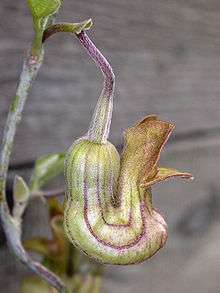Aristolochiaceae
| Aristolochiaceae | |
|---|---|
 | |
| California Pipevine (Aristolochia californica) | |
| Scientific classification | |
| Kingdom: | Plantae |
| Clade: | Angiosperms |
| Clade: | Magnoliids |
| Order: | Piperales |
| Family: | Aristolochiaceae Juss. |
| Subfamilies | |
| |
| Synonyms | |
| |
The Aristolochiaceae (English /əˌrɪstəˈloʊkiəsii/) are a family, the birthwort family, of flowering plants with seven genera and about 400 known species belonging to the order Piperales. The type genus is Aristolochia L.
Description
They are mostly perennial, herbaceous plants, shrubs, or lianas. The membranous, cordate simple leaves are spread out, growing alternately along the stem on leaf stalks. The margins are commonly entire. No stipules are present. The bizarre flowers are large to medium-sized, growing in the leaf axils. They are bilaterally or radially symmetrical.
Classification
Aristolochiaceae are magnoliids, a basal group of angiosperms which are not part of the large categories of monocots or eudicots. As of APG IV APG IV (2016), the former families Hydnoraceae and Lactoridaceae are included, because exclusion would make Aristolochiaceae in the traditional sense paraphyletic.[2]
Some newer classification schemes, such as the update of the Angiosperm Phylogeny Group, place the family Aristolochiaceae in the order Piperales, but it is still quite common, though superseded, for the Aristolochiaceae to be assigned, sometimes with some other families, their own order (Aristolochiales).
Phytochemistry
Many members of Aristolochia and some of Asarum contain the toxin aristolochic acid, which discourages herbivores and is known to be carcinogenic in rats. Aristolochia species are carcinogenic to humans.
Ecology
Pipevine swallowtail butterflies lay their eggs on pipevine (Aristolochia species), and the larvae feed on the plant, but are not affected by the toxin, which then offers the adult butterfly protection against predators.
Classification
|
|
|
|
References
- ↑ "Family: Aristolochiaceae Juss., nom. cons.". Germplasm Resources Information Network. United States Department of Agriculture. 2007-04-12. Retrieved 2011-01-09.
- ↑ Angiosperm Phylogeny Group (2016). "An update of the Angiosperm Phylogeny Group classification for the orders and families of flowering plants: APG IV". Botanical Journal of the Linnean Society. 181 (1): 1–20. doi:10.1111/boj.12385.
- ↑ "GRIN Genera of Aristolochiaceae subfam. Asaroideae". Germplasm Resources Information Network. United States Department of Agriculture. Retrieved 2011-01-09.
- ↑ "GRIN Genera of Aristolochiaceae subfam. Aristolochioideae". Germplasm Resources Information Network. United States Department of Agriculture. Retrieved 2011-01-09.
External links
| Wikimedia Commons has media related to Aristolochiaceae. |
| Wikispecies has information related to: Aristolochiaceae |
- International Agency for Research on Cancer evaluation
- Dietary Supplements: Aristolochic Acid, U.S. Food and Drug Administration alerts
- Health Canada advising not to use products labelled to contain Aristolochia